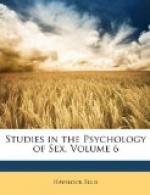[321] Howard, op. cit., vol. i, p. 259; Smith and Cheetham, Dictionary of Christian Antiquities, art. Arrhae. It would appear, however, that the “bride-sale,” of which Tacitus speaks, was not strictly the sale of a chattel nor of a slave-girl, but the sale of the mund or protectorship over the girl. It is true the distinction may not always have been clear to those who took part in the transaction. Similarly the Anglo-Saxon betrothal was not so much a payment of the bride’s price to her kinsmen, although as a matter of fact, they might make a profit out of the transaction, as a covenant stipulating for the bride’s honorable treatment as wife and widow. Reminiscences of this, remark Pollock and Maitland (op. cit., vol. ii, p. 364), may be found in “that curious cabinet of antiquities, the marriage ritual of the English Church.”
[322] Howard, op. cit., vol. i, pp. 278-281, 386. The Arrha crept into Roman and Byzantine law during the sixth century.
[323] J. Wickham Legg, Ecclesiological Essays, p. 189. It may be added that the idea of the subordination of the wife to the husband appeared in the Christian Church at a somewhat early period, and no doubt independently of Germanic influences; St. Augustine said (Sermo XXXVII, cap. vi) that a good materfamilias must not be ashamed to call herself her husband’s servant (ancilla).
[324] See, e.g., L. Gautier, La Chevalerie, Ch. IX.
[325] Howard, op. cit., vol. i, pp. 293 et seq.; Esmein, op. cit., vol. i, pp. 25 et seq.; Smith and Cheetham, Dictionary of Christian Antiquities art. “Contract of Marriage.”
[326] Any later changes in Catholic Canon law have merely been in the direction of making matrimony still narrower and still more remote from the practice of the world. By a papal decree of 1907, civil marriages and marriages in non-Catholic places of worship are declared to be not only sinful and unlawful (which they were before), but actually null and void.
[327] E.S.P. Haynes, Our Divorce Law, p. 3.
[328] It was the Council of Trent, in the sixteenth century, which made ecclesiastical rites essential to binding marriage; but even then fifty-six prelates voted against that decision.
[329] Esmein, op. cit., vol. i, p. 91.
[330] It is sometimes said that the Catholic Church is able to diminish the evils of its doctrine of the indissolubility of marriage by the number of impediments to marriage it admits, thus affording free scope for dispensations from marriage. This scarcely seems to be the case. Dr. P.J. Hayes, who speaks with authority as Chancellor of the Catholic Archdiocese of New York, states ("Impediments to Marriage in the Catholic Church,” North American Review, May, 1905) that even in so modern and so mixed a community as this there are few applications for dispensations on account of impediments; there are 15,000 Catholic marriages per annum in New York City, but scarcely five per annum are questioned as to validity, and these chiefly on the ground of bigamy.




